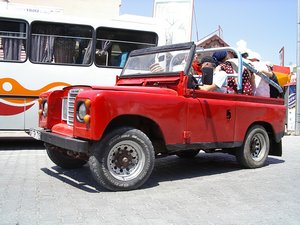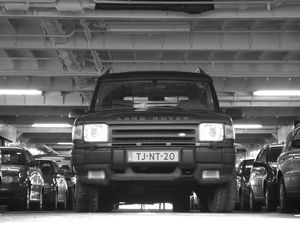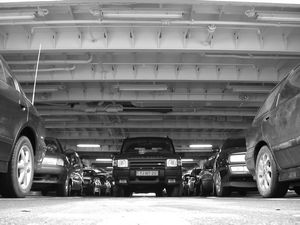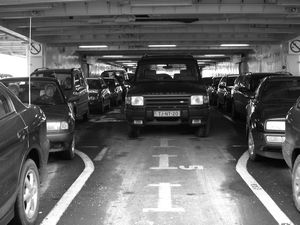















Land Rover |
|---|
|
| Topic Navigation |
|---|
|
Wikipedia: Land Rover
Subtopics Redbourne Wheels Page Sections History Multimedia Photographs Article Index |
History
The following section is an excerpt from Wikipedia's Land Rover page on 29 October 2015, text available via the Creative Commons Attribution-ShareAlike 3.0 Unported License.
The design for the original Land Rover vehicle was started in 1947 by Maurice Wilks, chief designer at the Rover Company, on his farm in Newborough, Anglesey. The design may have been influenced by the Jeep[8] and the prototype, later nicknamed Centre Steer, was built on a Jeep chassis and axles.[9] The early choice of colour was dictated by military surplus supplies of aircraft cockpit paint, so early vehicles only came in various shades of light green; all models until recently feature sturdy box section ladder-frame chassis. Early vehicles like the Series I, were field-tested at Long Bennington and designed to be field-serviced.
Land Rover as a company has existed since 1978. Prior to this, it was a product line of the Rover Company which was subsequently absorbed into the Rover-Triumph division of the British Leyland Motor Corporation (BL) following Leyland Motor Corporation’s takeover of Rover in 1967. The ongoing commercial success of the original Land Rover series models, and latterly the Range Rover in the 1970s in the midst of BL's well-documented business troubles prompted the establishment of a separate Land Rover company but still under the BL umbrella, remaining part of the subsequent Rover Group in 1988, under the ownership of British Aerospace after the remains of British Leyland were broken up and privatised. In 1994 Rover Group plc was acquired by BMW. In 2000, Rover Group was broken up by BMW and Land Rover was sold to Ford Motor Company, becoming part of its Premier Automotive Group. In 2006 Ford purchased the Rover brand from BMW for around £6 million.
In 2008, Ford Motor Company sold Jaguar and Land Rover to Tata Motors. Included in the deal were the rights to three other British brands: Jaguar's own Daimler marque, as well as two dormant brands Lanchester and Rover. BMW and Ford had previously retained ownership of the Rover brand to protect the integrity of the Land Rover brand, with which 'Rover' might be confused in the US 4x4 market; the Rover brand was originally used under licence by MG Rover until it collapsed in 2005, at which point it was re-acquired by the then Ford Motor Company owned Land Rover Limited. This sale also included the dormant Rover brand.[11][12][13] As of August 2012, most Land Rovers in production are powered by Ford engines.[14] Under the terms of the acquisition, Tata has the right to buy engines from Ford until 2019. In 2011, Tata confirmed plans that it is investing $559 million to build an engine assembly plant in the British West Midlands. However, it was only stated that the plant will produce four-cylinder engines. The eight-cylinder engines used in Land Rovers were not mentioned.
Timeline
1947: Rover's chief designer Maurice Wilks and his associates create a prototype using Jeep chassis and components
1948: The first Land Rover was officially launched 30 April 1948, at the Amsterdam Motor Show
1958: Series II launched
1961: Series IIA began production
1967: Rover becomes part of Leyland Motors Ltd, later British Leyland (BL) as Rover Triumph
1970: Introduction of the Range Rover
1971: Series III launched
1974: Land Rover abandons US market, facing competitive pressure from Japanese 4x4 brands
1975: BL collapses and is nationalised, publication of the Ryder Report recommends that Land Rover be split from Rover and be treated as a separate company within BL and becomes part of the new commercial vehicle division called the Land Rover Leyland Group
1976: One-millionth Land Rover leaves the production line
1978: Land Rover Limited formed as a separate subsidiary of British Leyland
1980: Rover car production ends at Solihull with the transfer of SD1 production to Cowley, Oxford; Solihull is now exclusively for Land Rover manufacture. 5-door Range Rover introduced.
1983: Land Rover 90 (Ninety)/110 (One-Ten)/127 (renamed Defender in 1990) introduced
1986: BL plc becomes Rover Group plc; Project Llama started
1987: Range Rover is finally introduced to the US market, following many years of demand being filled by grey market sales
1988: Rover Group is privatised and becomes part of British Aerospace, and is now known simply as Rover
1989: Introduction of Discovery
1994: Rover Group is taken over by BMW. Introduction of second-generation Range Rover. (The original Range Rover was continued under the name 'Range Rover Classic' until 1995)
1997: Land Rover introduces the Special Edition Discovery XD with AA Yellow paint, subdued wheels, SD type roof racks, and a few other off-road upgrades directly from the factory. Produced only for the North American market, the Special Vehicles Division of Land Rover created only 250 of these bright yellow SUV's.
1997: Introduction of Freelander
1998: Introduction of second generation of Discovery
2000: BMW breaks up the Rover Group and sells Land Rover to Ford for £1.8 billion
2002: Introduction of third-generation Range Rover
2004: Introduction of third-generation Discovery/LR3
2005: Introduction of Range Rover Sport
2005: Adoption of Jaguar AJ-V8 engine to replace the BMW M62 V8 in the Range Rover
2005: Land Rover 'founder' Rover, collapses under the ownership of MG Rover Group
2006: Announcement of a new 2.4-litre diesel engine, 6-speed gearbox, dash and forward-facing rear seats for Defender. Introduction of second generation of Freelander (Freelander 2). Ford acquires the Rover trademark from BMW, who previously licensed its use to MG Rover Group
8 May 2007: 4,000,000th Land Rover rolls off the production line, a Discovery 3 (LR3), donated to The Born Free Foundation
12 June 2007: Announcement from the Ford Motor Company that it plans to sell Land Rover and also Jaguar Cars
August 2007: Tata Motors and Mahindra and Mahindra as well as financial sponsors Cerberus Capital Management, TPG Capital and Apollo Global Management expressed their interest in purchasing Jaguar Cars and Land Rover from the Ford Motor Company.
26 March 2008: Ford agreed to sell their Jaguar Land Rover operations to Tata Motors.
2 June 2008: Tata Motors finalised their purchase of Jaguar and Land Rover from Ford.
2010: Introduction of fourth-generation Discovery/LR4
2011: The Range Rover Evoque introduced
2012: Fourth-generation Range Rover was exhibited at the 2012 Paris Motor Show
2014: The New Discovery Range exhibited at the 2014 New York Motor show
| Date | Media or Collection Name & Details | Files |
|---|---|---|
| 26 March 2008 | Indian Company Buys Luxury Brands Jaguar, Land Rover Anjana Pasricha for Voice of America News | Article Page - 2:02 |
Photographs
The following photographs cannot be identified. If you know any details about these images, please e-mail admin@carsandracingstuff.com.
 |
Subject: Classic Land Rover
Source: Image*After View photo of Classic Land Rover - 745KB |
 |
Subject: Land Rover on a Ferry
Source: Image*After View photo of Land Rover on a Ferry - 745KB |
 |
Subject: Land Rover on a Ferry
Source: Image*After View photo of Land Rover on a Ferry - 826KB |
 |
Subject: Land Rover on a Ferry
Source: Image*After View photo of Land Rover on a Ferry - 759KB |
